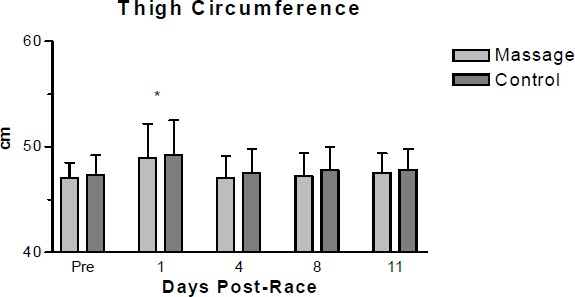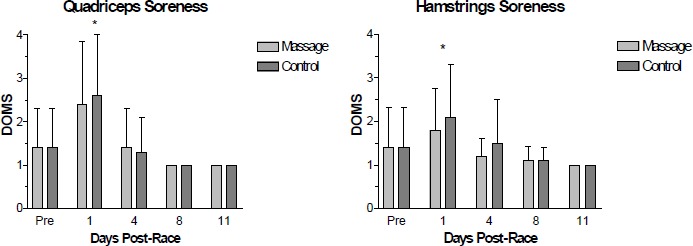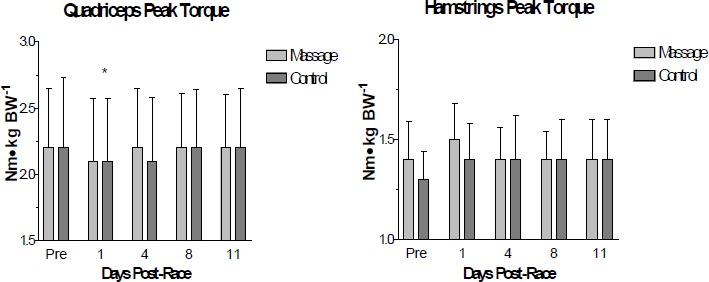Abstract
Massage therapy is commonly used following endurance running races with the expectation that it will enhance post-run recovery of muscle function and reduce soreness. A limited number of studies have reported little or no influence of massage therapy on post-exercise muscle recovery. However, no studies have been conducted in a field setting to assess the potential for massage to influence muscle recovery following an actual endurance running race. To evaluate the potential for repeated massage therapy interventions to influence recovery of quadriceps and hamstring muscle soreness, recovery of quadriceps and hamstring muscle strength and reduction of upper leg muscle swelling over a two week recovery period following an actual road running race. Twelve adult recreational runners (8 male, 4 female) completed a half marathon (21.1 km) road race. On days 1,4, 8, and 11 post-race, subjects received 30 minutes of standardized massage therapy performed by a registered massage therapist on a randomly assigned massage treatment leg, while the other (control) leg received no massage treatment. Two days prior to the race (baseline) and preceding the treatments on post-race days 1, 4, 8, and 11 the following measures were conducted on each of the massage and control legs: strength of quadriceps and hamstring muscles, leg swelling, and soreness perception. At day 1, post-race quadriceps peak torque was significantly reduced (p < 0.05), and soreness and leg circumference significantly elevated (p < 0.05) relative to pre-race values with no difference between legs. This suggested that exercise-induced muscle disruption did occur. Comparing the rate of return to baseline measures between the massaged and control legs, revealed no significant differences (p > 0.05). All measures had returned to baseline at day 11. Massage did not affect the recovery of muscles in terms of physiological measures of strength, swelling, or soreness. However, questionnaires revealed that 7 of the 12 participants perceived that the massaged leg felt better upon recovery.
Key Points.
Massage does not appear to affect physiological indices of muscle recovery post exercise.
Massage does appear to positively influence perceptions of recovery.
More research needs to be completed on the purported benefits of massage.
Key words: Recovery, running, perception, massage
Introduction
Many coaches, athletes, and therapists suggest that massage is capable of increasing the recovery rate of an exercise-damaged muscle. Among the more overt symptoms associated with exercise induced muscle damage or disruption are a prolonged loss of muscle force, swelling and soreness. One need only look toward the finish line of many sporting events such as road races, triathlons, and swimming meets to witness the number of participants who believe in the ability of massage to influence these and other post-exercise symptoms of muscle damage and indulge in post-race massage. However, support for the benefits of massage has largely been anecdotal, rather than empirical. In recent reviews of the massage related exercise damage research, Tiidus (1997; 2002) concluded that the limited evidence currently available does not yet support the use of massage as an important therapeutic intervention in the repair of exercise-induced muscle damage or in the recovery from exercise. In fact, the studies that have investigated the relationship between massage and muscle function following exercise have been inconclusive or unable to detect a difference (e.g., DuCharme et al., 1999; Farr et al., 2002; Hemmings et al. , 2000, Martin et al., 1998; Tiidus and Shoemaker, 1995). For example, Tiidus and Shoemaker (1995) reported that the rate of quadriceps muscle force recovery up to 96 hr following eccentric exercise induced damage was not influenced by repeated massage treatments and the perception of muscle soreness was only minimally reduced at one time point by massage. Although it is often cited as the means of massages’ therapeutic effect, several studies have also conclusively demonstrated with the use of Doppler ultrasound that massage of any type does not influence muscle blood flow (Tiidus and Shoemaker, 1995; Shoemaker et al., 1997; Hinds et al., 2004). Hemmings (2001) concluded that while the claims of physiological benefits associated with massage such as increased blood flow and lactate removal and alleviated post-exercise muscle soreness lack scientific credibility, massage may be beneficial on individual perceptions of recovery. Callaghan (1993) stated that the role of massage, which is a time-consuming technique to perform, needs to be evaluated further in order to justify its use. Anecdotal evidence is no longer sufficient evidence and controlled field research is necessary.
The purpose of the present study was to evaluate the ability of massage to enhance recovery after an intense bout of exercise (running a half marathon road race). The present study offers a more externally valid approach to understanding the benefits of massage than offered in previous research. Most previous research (e.g., Tiidus and Shoemaker, 1995; DuCharme et al., 1999) has been conducted in a controlled environment with researcher induced muscle damage while the present study attempts to evaluate how massage may benefit muscle recovery after an actual exercise bout. Chiu et al. (2001) suggested that the use of eccentric exercise models to damage the muscle in previous research does not realistically represent the training athlete who utilizes at least 50% concentric contractions. Similarly, evaluating untrained individuals speaks very little to how massage affects the post event recovery of trained athletes. The present study, therefore, aims to present some key additions to previous exercise and massage related research. In addition to the realistic protocol being utilized, the external validity of the research design was further strengthened by selecting participants that would normally seek or perceive a need for massage treatment as well as implementing a massage schedule and treatment protocol normally used by massage therapists when dealing with muscle break down consequent to running.
Methods
Subjects
Twelve healthy subjects (8 males, 4 females) aged 24-51 years (mean ± SD = 35.2 ± 8.3 yrs) participated in the study. The participants were recruited from the St. John’s Ambulance Marathon where all subjects had selected to run a half marathon. The participants completed a PAR-Q health and physical activity questionnaire and signed consent to participate in the investigation that had been approved by the Wilfrid Laurier Ethics Research Board. The range of running experience was diverse, spanning from 1 to 144 months of training prior to the race (mean ± SD = 65.7 ± 55.3 months). The final race times also demonstrated the diversity of the participants (mean ± SD = 111.70 ± 17.8 minutes, range: 93-143 minutes). Eighty-three percent of the participants indicated that they had run road races previously (10km: 5 participants, ½ marathon: 2 participants, marathon: 3 participants). Only two of the runners had not run a previous race. The participants ran an average of 22 ± 7.3 miles·week-1 (35.0±11.7 km·week-1) before the race. Although our intent was to recruit relatively novice or inexperienced runners, this did not transpire and most were reasonably well-established runners. Further questioning, revealed that most runners were using the race as a training run for spring marathons. Ninety-one percent of the participants were not using massage therapy as part of their training regimen while 58% of the runners had never used massage previously. All participants indicated that they were using the typical post race running strategies of stretching and icing. No participants were using anti-inflammatory medication.
Measures
Strength: The CYBEX II isokinetic dynamometer was used to measure quadriceps and hamstring muscle strength. Each participant performed one set of three maximal voluntary contractions with the quadriceps and then the hamstring muscles with a rest of 10 seconds in between each repetition. In order to determine peak torque of the muscle, dynamic isokinetic concentric contractions at 60 degrees per second were measured in Newton-metres (Nm) and normalized across subjects as Nm per kg body weight (Nm·kg-1 BW) (Sale 1991). The best or peak measure was used for both the hamstring and quadriceps muscles. Each individual began the CYBEX testing with a randomly assigned leg each test day. Visual feedback of the contraction was available for the participant from the computer screen and subjects were verbally encouraged to maximize contraction efforts. Changes in muscle torque were interpreted to primarily reflect muscle peripheral contractile disruption. Physiologically, anything from possible sarcolemma or sarcoplasimc reticulum disruption to physical damage to sarcomeres, z- lines or contractile proteins changes could account for this loss of force from exercise induced muscle damage (Fitts 1994). Changes in dynamic peak torque are generally thought to represent the best non- invasive in vivo measure of physiological muscle damage and recovery (Warren et al., 1999). Although muscle force may decrease following eccentric contractions due to neuromuscular fatigue as well, recent animal research suggests that the prolonged post-damage loss of force may primarily reflect physical disruption of contractile elements (Ingalls et al., 2004).
Leg Swelling: Thigh circumference was measured at a point 15 cm from the base of the patella. A permanent marker was used to mark the location on the skin of the thigh to allow repeated measures to be taken at the same location on each participant. Muscle swelling is typically seen following exercise induced damage and measures of leg circumference is a simple indirect method to indirectly assess swelling in hamstring and quadriceps muscles (Cleak and Eston, 1992).
Soreness: An adapted Graphic Ratings Scale (GRS) that has been demonstrated by Mattacola et al. (1997) to be both valid and reliable for assessing delayed onset muscle soreness (DOMS) was used to assess soreness preception. Participants indicated the amount of soreness that they were currently experiencing in both their quadriceps and hamstring muscles on 7 point graphic linear scales with anchors of 1 (no pain) to 7 (unbearable pain). Soreness was assessed prior to massage treatment on each of the assessment/treatment days to determine the potential longer term effects of massage. While often associated with physical disruption and muscle damage, muscle soreness may be more reflective of muscle inflammation and repair mechanisms than muscle damage itself as damage can occur in the absence of muscle soreness and vice versa (Armstrong et al., 1984).
Massage Treatment: Each participant had one leg randomly massaged while the non-massaged leg served as the control. Two registered massage therapists trained in sport massage administered all treatments that lasted approximately 30 minutes. The protocol was determined and standardized by the therapists prior to the start of the study and was based on previous experience with runners. Treatment began with effleurage: light to moderate pressure with a fluid stroking motion (also called flushing). This began with the participant in the supine position. The participants moved into the prone position where the light to moderate flushing continued. The beginning portion of the massage lasted 5 minutes. Following this, petrissage was applied using shaking and deeper strokes including moderate to deep motions for 15 minutes. Passive stretching of the massage treatment leg followed, which included stretches to the quadriceps, hamstrings, glutes, piriformis, and psoas muscles with each muscle being held for a minimum of 30 seconds with the duration of stretching lasting 5 minutes. The low back was also addressed as a compensatory area that becomes stiff in many runners after a long race and was massaged using petrissage for 3 minutes. Finally, a quick, moderate flush (effleurage) was used to finish which lasted 2 minutes. All flushing during the massage was in a superior direction toward the inguinal lymph chain. The initial treatment that immediately followed the race was the lightest with each successive treatment becoming more aggressive in depth and muscle challenge.
Procedure
Subjects were contacted based on their registration in the St. John’s Ambulance Marathon and asked to volunteer for the study. During the week prior to the race, subjects came to the lab to be familiarized with the CYBEX machine in order to diminish any learning effects. Two days prior to the race, participants visited the lab again to assess baseline measures of strength, soreness, and upper leg circumference. Subjects also completed a background history questionnaire that included previous injuries and post-race treatment methods, a training regimen for a typical week, and previous running experience. On days 1, 4, 8, and 11 post race assessments of pain, strength, and leg circumference were performed. During each of the post-race test days, the participants were measured first for the circumference of their upper thighs, then tested on the CYBEX, and finally massaged for 30 minutes. Following the massage, the participants assessed the degree of pain they were experiencing in their hamstrings and quadriceps muscles.
Statistics
Descriptive statistics were run to capture participant characteristics. Means and standard deviations for all key variables (strength, leg circumference, and pain) are evident in Figure 1 and Figure 3. Paired T-tests were run on the pain, leg circumference, and strength measures pre and immediately post race (time 1) to evaluate immediate changes due to running the race. In order to evaluate whether the massage treatment helped the runners return to baseline measures faster than nontreatment or control, a repeated measure ANOVA was completed with two factors. The within group factor was TIME (pre, days1, 4, 8 and 11) and the between group factor was TREATMENT (massage leg vs control leg).
Figure 1.

Effects of repeated massage treatments on upper thigh circumference. * Massage and control leg greater than pre-race values (p < 0.05).
Figure 3.

Effect of repeated massage on quadriceps and hamstring soreness.Massage and control leg significantly higher than pre-race values (p < 0.05).
Results
Paired T-tests completed on the strength, pain, and circumference measures at pre and immediately post race (day 1) indicated that significant changes occurred in all three areas (p < 0.05). As expected, strength significantly decreased in the quadriceps muscle, while quadriceps and hamstring soreness and leg circumference increased, thereby, indicating that a significant exercise event took place. However, the treatment by time repeated measures ANOVA indicated that the massage leg did not return to baseline measures of strength, soreness, or leg circumference any faster than the control group (p > 0.05). The ANOVA results are highlighted in Figure 1, Figure 2 and Figure 3.
Figure 2.

Effect of repeated massage on quadriceps and hamstring peak torque. Massage and control leg significantly lower than pre-race values (p < 0.05).
Discussion
In agreement with Hemmings’ (2001), conclusion, therapeutic massage post race does not appear to alleviate physiological symptoms of endurance activities such as muscle strength loss, swelling or soreness faster than the no treatment condition. Although all measures returned to baseline 11 days after the race, massage did not lead to an increased rate of return. These results tended to confirm previous laboratory based studies, which also found little influence of massage on indices of recovery from eccentric exercise induced muscle damage (i.e. Tiidus and Shoemaker 1995).
However, a qualitative review of participant’s comments indicated that 7 of the participants took the time to comment on the differences between the massaged and non-massaged leg. These comments included statements such as, ‘More relaxed in massaged leg’, ‘Less stiff in massaged leg’, ‘Massage leg felt better while weight lifting’, ‘Feels different between legs when walking downstairs - massage feels better’, ‘Massage leg feels less pain’, ‘Massage leg feels looser when running’. These statements are indicative of the subjective impressions of improvements that massage can make. According to Hemmings (2001), although studies on the psychological effects of massage are few in number, research seems to suggest that massage may have positive effects on perceptions of recovery.
Similarly, DuCharme et al. (1999) suggested that perhaps sport-related methodologies are not adequately capturing the possible benefits of massage. For example, massage therapists do not purport to increase strength or decrease muscle swelling, therefore, it is not surprising that no measurable differences emerged between the massaged and non-massaged leg. However, the challenge remains with massage therapists to operationally define anticipated improvements or changes due to massage therapy so that scientific evaluations of these claims may take place.
The findings of the present study may have been limited by the following factors. First, due to the reduced subject numbers, we were forced to compare a massaged leg to a non-massaged leg on the same participant. A between subject model would have possibly captured greater variation among subjects resulting in greater effect sizes. Second, our goal was to evaluate a true representation of how massage treatments are used by runners in exercise recovery. As such, it suffered from the threats to internal validity inherent to all field research. For example, although the massage protocol was standardized, treatments were provided by three therapists. This may have contributed to variability in massage treatments. Also, participants do recover psychologically and physically at different rates. A standardized recovery schedule for testing may not have captured true recovery changes.
Future directions based on the findings of the present study indicate that more research is required into investigating the role of subjective perception of recovery following massage and how this may influence other holistic aspects of post race recovery. Although it appeared at the outset that the present study suffered from the limitation of subjects having only one leg massaged and comparing it to a non-massaged leg, this in the end allowed the subject to make a direct comparison and detect subtle differences among the legs. The question remains as to whether these changes are in some way functionally detectable or only perceived. Either way, massage may be able to help with exercise recovery in at least a subjective way. It remains to be seen in future studies whether these improvements are solely psychological or whether they have some physiological outcome.
Conclusion
The findings of this study suggest that massage may have minimal influence on the physiological indices of muscle recovery which were measured in this study following exercise. Nevertheless, there is some indication that subjective perception of functional recovery following exercise can be positively influenced by massage in at least some subjects. More research is needed to better define the roles and limitations of massage intervention in recovery of muscle function following exercise.
Acknowledgements
This study was funding through a grant form the College of Massage Therapists of Ontario (CMTO). We are grateful to the CMTO for promoting this valuable line of research as well as to the director of the St. John’s Marathon, Tony Lea, who permitted us to seek participants from the race entrants.
Biographies
Lance DAWSON
Employment
Waterloo Sports Medicine Clinic, Waterloo ON Canada.
Degree
B.A., Registered Massage Therapist
Research interests
Massage and exercise recovery
Email: ladawson@rogers.com

Kimberley A. DAWSON
Employment
Associate Professor, Department of Kinesiology & PE, Wilfrid Laurier University, Waterloo ON Canada.
Degree
PhD
Research interests
Psychological factors in Exercise Adherence. Self-efficacy and exercise adherence in various populations. Massage therapy and recovery from exercise.
Email: kdawson@wlu.ca

Peter M. TIIDUS
Employment
Professor,Department of Kinesiology & PE, Wilfrid Laurier University, Waterloo ON, Canada.
Degree
PhD
Research interests
Physiology of muscle damage, inflammation and repair, therapeutic interventions in muscle repair, nutritional physiology.
Email: ptiidus@wlu.ca
References
- Armstrong R.B. (1984) Mechanisms of exercise-induced delayed onset muscular soreness: a brief review. Medicine and Science in Sports and Exercise 16, 529-538 [PubMed] [Google Scholar]
- Callaghan M.J. (1993) The role of massage in the management of the athlete: A review. British Journal of Sports Medicine 27, 28-33 [DOI] [PMC free article] [PubMed] [Google Scholar]
- Chiu L.Z., Weiss L.W., Fry A.C. (2001) Post-training massage: A review for strength and power athletes. Strength and Conditioning Journal 23, 65-69 [Google Scholar]
- Cleak M.J., Eston R.G. (1992) Muscle soreness, stiffness and strength loss after intense eccentric exercise. British Journal of Sports Medicine 26, 267-272 [DOI] [PMC free article] [PubMed] [Google Scholar]
- DuCharme K.A., Dawson L.G., Tiidus P.M. (1999) Manual massage and post-exercise muscle recovery. The Journal of Soft Tissue Massage winter, 4-5 [Google Scholar]
- Farr T., Nottle C., Nosaka K., Sacco P. (2002) The effects of therapeutic massage on delayed onset muscle soreness and muscle function following downhill walking. Journal of Science and Medicine in Sport 5, 297-306 [DOI] [PubMed] [Google Scholar]
- Fitts R.H. (1994) Cellular mechanisms of muscle fatigue. Physiological Reviews 74, 49-94 [DOI] [PubMed] [Google Scholar]
- Hemmings B.J. (2001) Physiological, psychological and performance effects of massage therapy in sport: A review of the literature. Physical Therapy in Sport 2, 165-170 [Google Scholar]
- Hemmings B., Smith M., Graydon J., Dyson R. (2000) Effects of massage on physiological restoration, perceived recovery, and repeated sports performance. Journal of Sports Medicine 34, 109-115 [DOI] [PMC free article] [PubMed] [Google Scholar]
- Hinds T., McEwan I., Perkes J., Dawson E., Ball D., George K. (2004). Effects of massage on limb and skin blood flow after quadriceps massage. Medicine and Science in Sports and Exercise 36, 1308-1313 [DOI] [PubMed] [Google Scholar]
- Ingalls C.P., Wenke J.C., Nofal T., Armstrong R.B. (2004) Adaptation to lengthening contraction-induced injury in mouse muscle. Journal of Applied Physiology 97, 1067-1076 [DOI] [PubMed] [Google Scholar]
- Martin N.A., Zoeller R.F., Robertson R.J., Lephart S.M. (1998) The comparative effects of sports massage, active recovery, and rest in promoting blood lactate clearance after supramaximal leg exercise. Journal of Athletic Training 33, 30-35 [PMC free article] [PubMed] [Google Scholar]
- Mattacola C.G., Perrin D.H., Gansneder B.M., Allen J.D., Mickey C.A. (1997) A comparison of visual analog and graphic rating scales for assessing pain following delayed onset muscle soreness. Journal of Sport Rehabilitation, 6 ,38-46 [Google Scholar]
- Sale D.G. (1991) Testing strength and power. : Physiological testing of the high-performance athlete. MacDougall J.D., Wenger H.A., Green H.J.2nd edition Human Kinetics Publishers, Champaign Illinois: 21-106 [Google Scholar]
- Shoemaker J.K., Tiidus P.M., Mader R. (1997) Failure of manual massage to alter limb blood flow: Measures by Doppler ultrasound. Medicine and Science in Sports and Exercise 29, 610-614 [DOI] [PubMed] [Google Scholar]
- Tiidus P.M. (1997) Manual massage and recovery of muscle function following exercise: A literature review. Journal of Orthopaedic Sports Physical Therapy 25, 107-112 [DOI] [PubMed] [Google Scholar]
- Tiidus P.M. (2002) Massage and the athlete: Often used, rarely researched. Acta Academiae Olympiquae Estoniae 10, 5-15 [Google Scholar]
- Tiidus P.M., Shoemaker J.K. (1995) Effleurage massage, muscle blood flow and long-term post-exercise strength recovery. International Journal of Sports Medicine 16, 478-483 [DOI] [PubMed] [Google Scholar]
- Warren G.L., Lowe D.A., Armstrong P.B. (1999) Measurement tools used in the study of eccentric contraction-induced injury. Sports Medicine 27, 43-59 [DOI] [PubMed] [Google Scholar]


